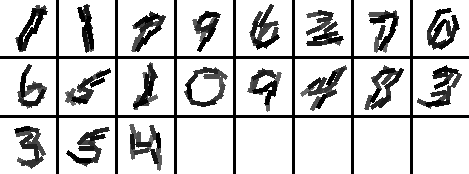Experiment 9
Learning local representative templates
Past results and code
The code below is not nearly as efficient as the current code posted above. It performs
unnecessary inhibition steps on all the images in learning. We keep it just for our own record.
In experiment 9 (outdated), we learn local representatives in an ensemble of 123 images of animal heads.
Around each image, we learn a template from this image and its K nearest neighbors, using an
iterative scheme based on the active correlation. Specifically, we first learn a template for
this single image where no activity is allowed. Then using the learned template, we find K
nearest neighbors by active correlation, where activity is restored. After that we re-learn the
template from this image and its K nearest neighbors. The weight for each of the K nearest
neighbors is 1, whereas the weight for this image is $\rho K$. In our experiment, K = 5, and
$\rho$ = 1/3. Then again, we find the K-nearest neighbors, and iterate. After learning all the
templates, we trim them to satisfy the constraint that the neighbors of the remaining templates
should not overlap (this may be too aggressive). This leaves 16 templates.
The local learning identifies the local dimensions and local "metric" in the image ensemble.
(1)
data, codes, and readme for local learning based on active correlation
(1.1)
data and codes based on likelihood

Experiment 9.1. The 16 representative templates locally learned by active correlation.
They are ordered by the total alignment scores. Image size is 100*100. Number of elements is 40.
Number of iteration is 3 for learning each template. The allowed activity of location is up to
2 pixels. The allowed activity of orientation is up to pi/15.
eps
The following are the 16 templates and their corresponding 5 nearest neighbors.
 eps
eps
 eps
eps
 eps
eps
 eps
eps
 eps
eps
 eps
eps
 eps
eps
 eps
eps
 eps
eps
 eps
eps
 eps
eps
 eps
eps
 eps
eps
 eps
eps
 eps
eps
 eps
eps
data, codes, and readme with follow-up k-mean clustering
We can use the learned template as the starting point for the k-mean clustering based on
active correlation.
results of k-mean clustering
The last two clusters are removed because each of them only contains one image.
All the 123 templates
Listed in the descending order of active correlation scores.
(2)
another example

Experiment 9.2. The 19 templates locally learned by active correlation. Number of
images is 200, image size is 56*56, taken from MNIST data set. Number of elements is 12.
Number of iteration is 3 for learning each template. The allowed activity of location is
up to 2 pixels. The allowed activity of orientation is up to pi/15.
eps
results of k-mean clustering
Again we use the learned templates to initialize k-mean. We did not perform merging.
All the 200 templates
Listed in the descending order of active correlation scores.
Back to
active basis homepage

 eps
eps  eps
eps  eps
eps  eps
eps  eps
eps  eps
eps  eps
eps  eps
eps  eps
eps  eps
eps  eps
eps  eps
eps  eps
eps  eps
eps  eps
eps  eps
eps
